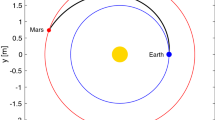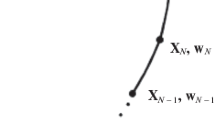Abstract
The Sequential Gradient Restoration Algorithm (SGRA) is an indirect optimisation method based on the iterative alternation of two phases: in the first one (gradient), the objective is the minimisation of the cost function; in the second phase (restoration) the objective is the fulfilment of the differential equations, equality and inequality path constraints and boundary conditions. This paper illustrates the application of the SGRA to the generation of very long transfer trajectories (up to some few thousand orbits during several months) in a typical GTO to GEO transfer scenario performed with electric propulsion. The reason for using electric propulsion in that case is the significant propellant mass savings if compared to the classical chemical propulsion strategies, at the expenses of an elongated transfer phase (from few days to some months). The electric propulsion system considered in this paper is characterised by thrust levels between 100 mN and 1 N (for some 3 to 5 tons launch mass) and high specific impulse, between 1000 s and 5000 s.
Similar content being viewed by others
Abbreviations
- Ac:
-
collision cross-sectional area
- E:
-
eccentric anomaly
- F:
-
eccentric longitude
- I:
-
inertia matrix
- J:
-
cost function
- L:
-
angular momentum
- N:
-
norm squared of a vector
- P:
-
error in the constraints
- Q:
-
error in the optimality conditions
- S:
-
path constraints
- T:
-
torque
- a:
-
semi-major axis
- e:
-
eccentricity
- i:
-
inclination
- n:
-
debris density
- pc:
-
cumulative collision probability
- t:
-
time
- u:
-
control vector
- x:
-
state vector
- y:
-
components of the state vector prescribed at the initial point
- z:
-
components of the state vector not prescribed at the initial point
- Ω:
-
right ascension of the ascending node
- α:
-
thrust vector elevation with respect to RTC
- β:
-
thrust vector azimuth with respect to RTC
- ζ:
-
boundary conditions at the initial point
- λ:
-
Lagrange multipliers for the state dynamics equa¬tion
- µ:
-
Lagrange multipliers for the end boundary con¬ditions
- π:
-
parameter vector
- ρ:
-
Lagrange multipliers for the path constraints
- σ:
-
Lagrange multipliers for the initial boundary con¬ditions
- ϕ:
-
dynamics
- ψ:
-
boundary conditions at the end point
- ω:
-
argument of perigee
- w⃗:
-
angular velocity
- Ḟ:
-
time derivative of F
- Fx:
-
partial derivative of F wrt x
- AOCS:
-
Attitude and Orbit Control System
- FOCP:
-
Full Optimal Control Problem
- GEO:
-
Geostationary Earth Orbit
- GTO:
-
Geostationary Transfer Orbit
- LEO:
-
Low Earth Orbit
- RTC:
-
Radial, Along-Track, Cross-Track reference system
- SAA:
-
Sun Aspect Angle
- SADM:
-
Solar Array Driving Mechanism
- SGRA:
-
Sequential Gradient Restoration Algorithm
- TPBVP:
-
Two-Point Boundary Value Problem
References
P.B. de Selding, SES Jumps on Electric-propulsion Bandwagon with Latest Satellite Order, 17 July 2014, http://spacenews.com/41288ses-jumps-on-electric-propulsion-bandwagon-with-latest-satellite/, (01.09.2017).
S. Clark, Boeing’s first two all-electric satellites ready for launch, 1 March 2015, https://www.spaceflightnow.com/2015/03/01/boeings-first-two-all-electric-satellites-ready-for-launch, (01.09.2017).
A. Miele, R.E. Pritchard, J.N. Damoulakis, “Sequential Gradient Restoration Algorithm for Optimal Control Problems”, Journal of Optimization Theory and Applications, Vol. 5, n. 4, 1970, pp. 235–282.
A. E. Bryson, “Applied Optimal Control”, 1975.
R. A. Broucke, P.J. Cefola, “On the equinoctial orbit elements”, Celestial Mechanics, Vol. 5, Issue 3, 1972, pp. 303–310.
D. A. Danielson, C.P. Sagovac, B. Neta, L.W. Early, “Semi-analytic satellite theory”, Naval Postgraduate School, 2010.
H. Klinkrad, “Space Debris: Models and Risk Analysis”, Springer (2006).
IADC Steering Group, “Space Debris: IADC Assessment Report for 2011”, IADC-12-06, 2013.
Low-Thrust Orbit Transfer Trajectory Optimization Software, https://www.astos.de/products/lotos
Author information
Authors and Affiliations
Rights and permissions
About this article
Cite this article
Bastante, J.C., Letizia, F., de Bruijn, F. et al. Application of the Sequential Gradient Restoration Algorithm to the Solution of the Low Thrust Transfer Problem. Aerotec. Missili Spaz. 96, 228–236 (2017). https://doi.org/10.1007/BF03404758
Published:
Issue Date:
DOI: https://doi.org/10.1007/BF03404758




